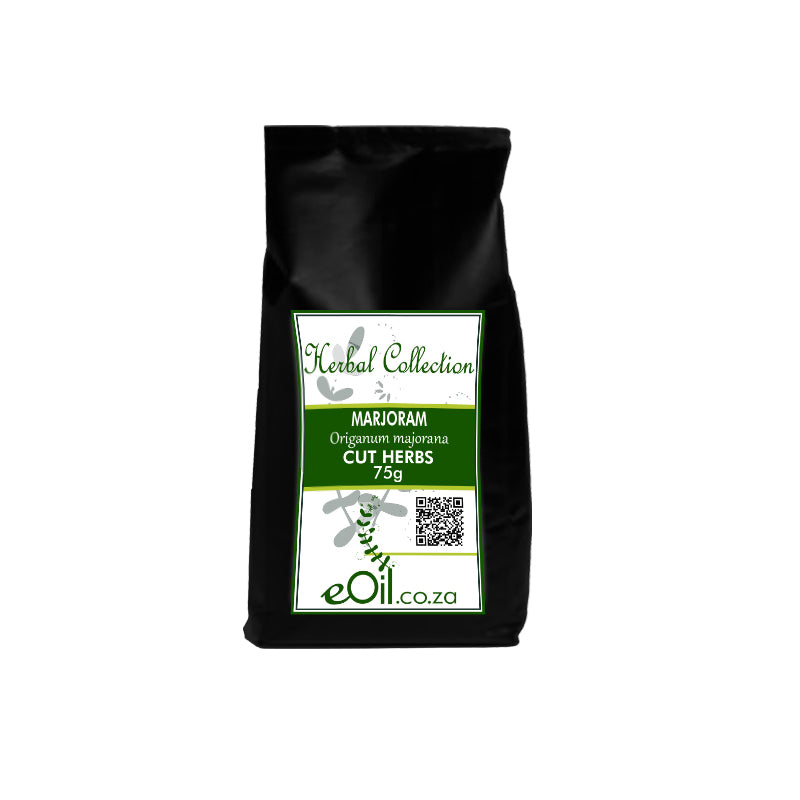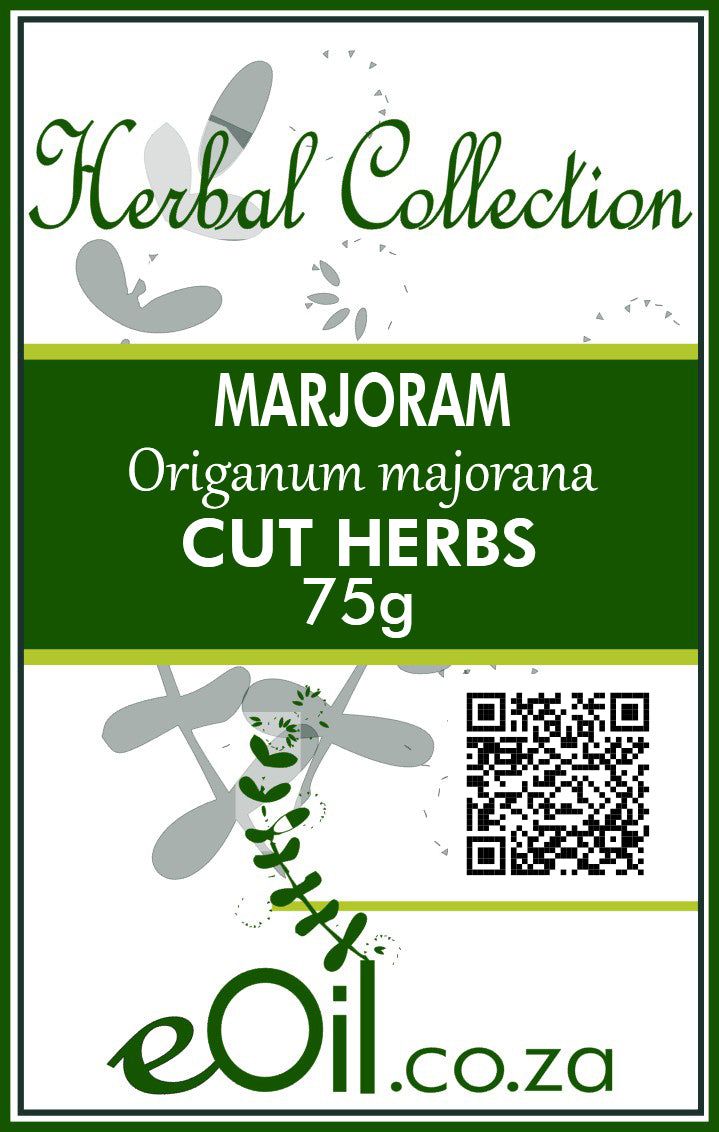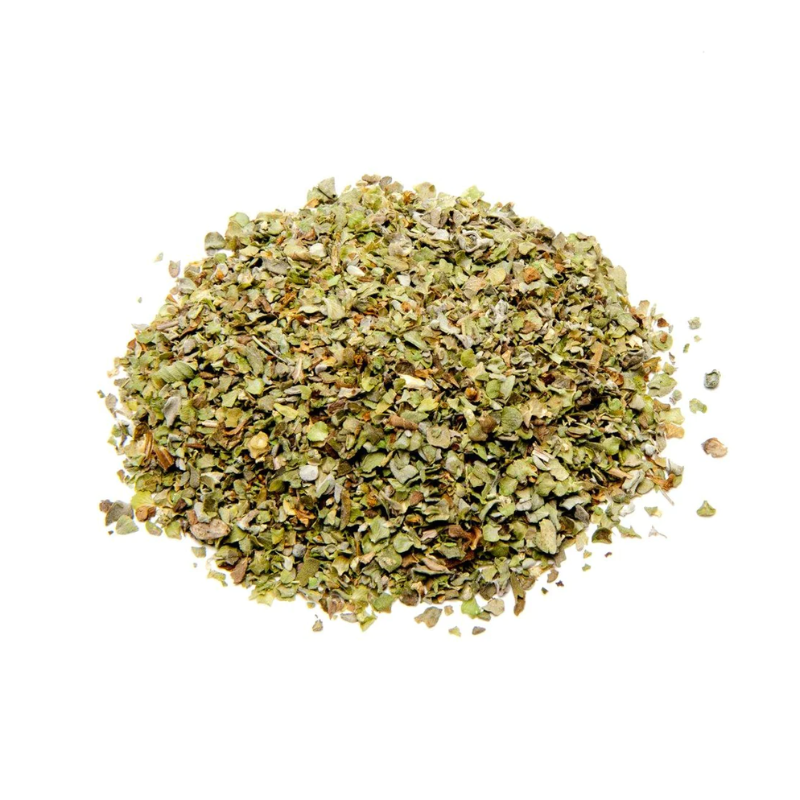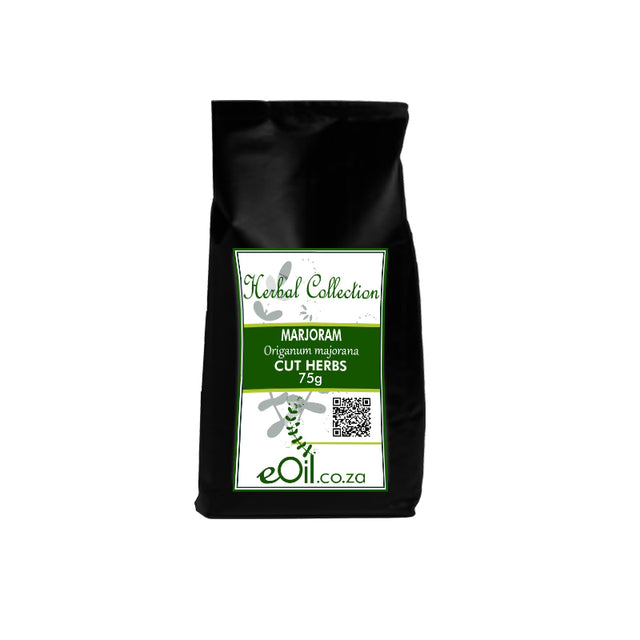Marjoram Herb cut - Herbal Collection
Marjoram Herb cut - Herbal Collection - 75 GR is backordered and will ship as soon as it is back in stock.
Description
Description
Marjoram Herb cut 75 g - Herbal Collection
Origanum majorana
TRADITIONALLY USED FOR
Marjoram herb tisane, also known as marjoram tea, is an infusion made from the dried leaves and flowers of the marjoram plant (Origanum majorana). It has several benefits, properties, and traditional uses, including:
Digestive aid: Marjoram tisane has been traditionally used to promote healthy digestion, alleviate stomach cramps, reduce gas, and relieve symptoms of indigestion.
Relaxation and stress relief: The calming properties of marjoram tea make it a popular choice for promoting relaxation, reducing stress, and aiding in sleep.
Respiratory support: Marjoram tisane has been used to alleviate respiratory issues such as coughs, colds, and sinus congestion due to its expectorant and decongestant properties.
Pain relief: The analgesic and antispasmodic properties of marjoram herb tisane can help alleviate muscle aches, joint pain, headaches, and menstrual cramps.
Immune system support: Marjoram tea has been traditionally used to boost the immune system and protect against infections due to its antibacterial and antiviral properties.
Cardiovascular support: Some traditional uses of marjoram tisane include improving blood circulation and maintaining healthy blood pressure levels.
Mood enhancer: Marjoram tea has been used to improve mood and reduce anxiety, stress, and depression due to its calming effects on the nervous system.
Antioxidant properties: Marjoram herb tisane is rich in antioxidants, which help protect cells from damage caused by free radicals and support overall health.
To enjoy marjoram herb tisane, steep 1-2 teaspoons of dried marjoram leaves and flowers in a cup of boiling water for 5-10 minutes. Strain and enjoy the tea, optionally sweetening it with honey or adding a splash of lemon juice.
It is important to consult a healthcare professional before consuming marjoram tisane, especially if you are pregnant, nursing, or have a medical condition.
INFORMATION
Source : http://www.wikiphyto.org/wiki/Marjolaine
Reference on http://www.wikiphyto.org
Translation in English by Google Translate (go to the page of the source linked | on Chrome cellphones go on the 3 dots on the top right and select translate in your preferred language | on laptop right click your mouse and select option translate when hoovering on the page
plant name
Marjoram, Marjoram with shells , Garden marjoram
International Latin denomination
Origanum majorana L. = Majorana hortensis Moench
botanical family
Description and habitat
- Perennial and woody aromatic plant, with oval leaves that give off a powerful sweet, spicy aroma, and white or pink flowers, grouped in spikes in the axils of the upper leaves
- Widespread throughout the Mediterranean basin (production: Egypt and France)
History and tradition
- The taxonomy and chemotaxonomy of the genus Origanum is complex
- Pay attention to the binominal Latin denomination, the vernacular names are not always indicative
- For example , Marjoram from Spain corresponds to Thymus mastichina
Parts used
- Leaves and flowering tops
Dosage forms available
- Flowering tops essential oil
- Origanum majorana tincture
- Herbal teas
- Extracts
Usual dosages
Composition
Main components of the plant
- 0.7 - 3% essential oil with alpha-terpineol , linalool , thuyanol ( cis-sabinene hydrate )
- Phenol acids : caffeic acid and rosmarinic acid
- Flavonoids
- Triterpene acids ( oleanolic acid , ursolic acid )
Main components of buds or young shoots
Main components of essential oil
- Monoterpene alcohols (50%): terpinene-4-ol 20%, thuyanol (cis- and trans-): trans-sabinene hydrate (= (E)-sabinene hydrate ) 18-20%, cis-sabinene hydrate ( = (Z)-sabinene hydrate = cis-4-thuyanol ) 3-5%, alpha terpineol , geraniol , linalool [1] , [2]
- Monoterpene hydrocarbons (40%) including sabinene , gamma-terpinene 12%, alpha-pinene and beta-pinene , myrcene , paracymene
- Sesquiterpene hydrocarbons : beta-caryophyllene , beta-elemene
- Terpene esters (3%): linalyl acetate , bornyl acetate
- Reunion Island essential oil contains terpinene-4-ol (38.4%), cis-sabinene hydrate (15.0%), p-cymene (7.0%), gamma-terpinene (6.9%) [3]
Properties
Plant properties
- Stimulant and antispasmodic
- Strong activity on the nervous system, neurotonic and slightly anti-depressant, anxiolytic and slightly soporific, sedative [4]
- Anticonvulsant [5]
- Inhibition of acetylcholinesterase, potential effect in Alzheimer's disease ( ursolic acid ) [6] , reduces beta-amyloid protein accumulation [7]
- Anti-migraine
- Boosts libido (?)
- Immunostimulant (?)
- Light cardiac tonic and antiarrhythmic ( oleanolic acid , ursolic acid )
Bud properties
Properties of essential oil
- Antibacterial [8] medium intensity
- Antifungal [9]
- Antispasmodic, sedative and calming of the nervous system, tranquilizer, parasympathicotonic
- Hypotensive, vasodilator, analgesic
- Aphrodisiac (?) or anaphrodisiac depending on the doses
- Favorable effect of massage on the psychological and immunological level, increases the rate of CD8 lymphocytes [10]
- Potentialities in Alzheimer's disease [11]
- Likely action of volatile compounds on the olfactory receptors of the nasal mucosa, inducing a nerve impulse to the olfactory bulb, then to the hippocampus, linked to learning and memory functions [12]
- Protects against kidney and liver toxicity from lead acetate [13]
Directions
Indications of the whole plant (phytotherapy)
- Benign acute bronchial diseases
- Digestive disorders, flatulence, colic, gastritis [14]
- Anxiety and insomnia
- Spasmophilia, autonomic dystonias
- Migraines
- Nervous breakdown
- Colds and stuffy nose in inhalations
- Male infertility in obese rats [15]
Indications of the bud (gemmotherapy)
Specific indications of essential oil (aromatherapy)
- Autonomic dystonias, tachycardias, arrhythmias, syncopal tendency, arterial hypertension, emotional dyspnoea
- Digestive disorders, colopathies and colitis by anti-inflammatory effect and inhibition of cytokines IL-1β, IL-6, GM-CSF and TNFα [16]
- Ulcers, gastritis due to Helicobacter pylori in association with cranberry by probable inhibition of urease (which transforms urea into toxic ammonia for the gastric mucosa) and inhibition of proline dehydrogenase at the level of the plasma membrane [17]
- Dysmenorrhea, a mixture of HE from lavender Lavandula officinalis , clary sage Salvia sclarea and marjoram Origanum majorana , applied locally in a proportion of 2:1:1, decreases the intensity and shortens the duration of pain in primary dysmenorrhea (study randomized clinical trial) [18]
- Genital erethism, sexual obsessions, anxiety and stress, restlessness, dizziness
- Rheumatic pains
- Neuro-vegetative dystonias of any type:
- respiratory: dyspnoea, spasmodic cough
- cardiovascular: hypertension, palpitations, extrasystoles
- digestive: aerophagia, dyspepsia, flatulence, gastritis
- sexual: obsession, erethism
- nervous: hyperkinesia, stress, anxiety, depression, dizziness, irritability, agitation
- Muscle cramps and contractures
- Lumbago, sciatica, rheumatism
Known or suspected mode of action
- Parasympathomimetic
Usual formulations
Regulations
- French Pharmacopoeia list A (leaf, flowering top)
Possible side effects and precautions for use
- Essential oil not recommended for pregnant women
- Dermacaustic HE , possible skin irritation in its pure state
Bibliographic references
- Aller↑ ME Komaitis, N. Ifanti-Papatragianni, E. Melissari-Panagiotou. Composition of the essential oil of marjoram (Origanum majorana L.). Food Chemistry, Volume 45, Issue 2, 1992, Pages 117-118, ISSN 0308-8146, https://doi.org/10.1016/0308-8146(92)90020-3 .
- Aller↑ Şarer, E., Scheffer, JJC, & Svendsen, AB (1982). Monoterpenes in the essential oil of Origanum majorana. Plantamedica, 46(12), 236-239.
- Aller↑ Vera, RR, & Chane-Ming, J. (1999). Chemical composition of the essential oil of marjoram (Origanum majorana L.) from Reunion Island. Food Chemistry, 66(2), 143-145.
- Aller↑ Ali Rezaie, Behboud Jafari, Ghafour Mousavi, Mehrdad Nazeri, Amirreza Ebadi, Changiz Ahmadeh and Elmira Habibi, 2011. Comparative Study of Sedative, Pre-Anesthetic and Anti-Anxiety Effect of Origanum majorana Extract with Diazepam on Rats. Research Journal of Biological Sciences, 6: 611-614. DOI: 10.3923/rjbsci.2011.611.614
- Aller↑ Dipti N. Deshmane, Chhaya H. Gadgoli, Ganesh V. Halade. Anticonvulsant effect of Origanum majorana L. Pharmacologyonline 1:64-78 (2007) [1]
- Aller↑ Chung YK, Heo HJ, Kim EK, Kim HK, Huh TL, Lim Y, Kim SK, Shin DH. Inhibitory effect of ursolic acid purified from Origanum majorana L on the acetylcholinesterase. Mol Cells. 2001 Apr 30;11(2):137-43. PMID 11355692
- Aller↑ Heo HJ, Cho HY, Hong B, Kim HK, Heo TR, Kim EK, Kim SK, Kim CJ, Shin DH. Ursolic acid of Origanum majorana L. reduces Abeta-induced oxidative injury. Mol Cells. 2002 Feb 28;13(1):5-11. PMID 11911474
- Aller↑ S. G. Deans, Katerina P. Svoboda. The antimicrobial properties of marjoram (Origanum majorana L.) Volatile Oil. Flavor and Fragrance Journal, Volume 5, Issue 3, pages 187–190, September 1990
- Aller↑ Charai, M., Mosaddak, M., & Faid, M. (1996). Chemical composition and antimicrobial activities of two aromatic plants: Origanum majorana L. and O. compactum Benth. Journal of Essential Oil Research, 8(6), 657-664.
- Aller↑ Kuriyama H, Watanabe S, Nakaya T, Shigemori I, Kita M, Yoshida N, Masaki D, Tadai T, Ozasa K, Fukui K, Imanishi J. Immunological and Psychological Benefits of Aromatherapy Massage. Evid Based Complement Alternate Med. 2005 Jun;2(2):179-184. Epub 2005 Apr 27. PMID 15937558
- Aller↑ Mossa, ATH, & Nawwar, GAM (2011). Free radical scavenging and antiacetylcholinesterase activities of Origanum majorana L. essential oil. Human & experimental toxicology, 30(10), 1501-1513.
- Aller↑ Maggio, A., Rosselli, S., & Bruno, M. (2016). Essential oils and pure volatile compounds as potential drugs in Alzheimer's disease therapy: An updated review of the literature. Current pharmaceutical design, 22(26), 4011-4027.
- Aller↑ El‐Ashmawy, IM, El‐Nahas, AF, & Salama, OM (2005). Protective effect of volatile oil, alcoholic and aqueous extracts of Origanum majorana on lead acetate toxicity in mice. Basic & clinical pharmacology & toxicology, 97(4), 238-243. [2]
- Aller↑ Saxena, D., Jayant, SK, Soni, K., & Neekhra, K. (2016). Origanum majorana, a potential herb for functional food. Eur. J.Pharm. Med. Res, 3(2), 321-325.
- Aller↑ Elwakf, Azza & El-Habibi, Elsayed & Abd El-Ghany, Eman. (2015). Preventing male infertility by marjoram and sage essential oils through modulating testicular lipid accumulation and androgens biosynthesis disruption in a rat model of dietary obesity. Egyptian Journal of Basic and Applied Sciences. 5. 10.1016/j.ejbas.2015.05.005.
- Aller↑ Alexandra Bukovská, Štefan Čikoš, Štefan Juhás, Gabriela Il'ková, Pavol Rehák, and Juraj Koppel. Effects of a Combination of Thyme and Oregano Essential Oils on TNBS-Induced Colitis in Mice Mediators Inflamm. 2007; 2007: 23296. [3]
- Aller↑ YT Lin, YI Kwon, RG Labbe, and K. Shetty. Inhibition of Helicobacter pylori and Associated Urease by Oregano and Cranberry Phytochemical Synergies. Environ Microbiol app. 2005 December; 71(12): 8558–8564. [4]
- Aller↑ Ou, M.-C., Hsu, T.-F., Lai, AC, Lin, Y.-T. and Lin, C.-C. (2012), Pain relief assessment by aromatic essential oil massage on outpatients with primary dysmenorrhea: A randomized, double-blind clinical trial. Journal of Obstetrics and Gynecology Research, 38: 817-822. https://doi.org/10.1111/j.1447-0756.2011.01802.x
- Franchomme, Penoel. Aromatherapy exactly. Ed. Roger Jollois. 1996. p. 384
- Johannes Novak, Christina Bitsch, Jan Langbehn, Friedrich Pank, Melpo Skoula, Yiota Gotsiou, Chlodwig M. Franz. Ratios of cis- and trans-Sabinene Hydrate in Origanum majorana L. and Origanum microphyllum (Bentham) Vogel. Biochemical Systematics and Ecology, Volume 28, Issue 7, August 2000, Pages 697-704
- Hiroko Kuriyama, Satoko Watanabe, Takaaki Nakaya, Ichiro Shigemori, Masakazu Kita, Noriko Yoshida, Daiki Masaki, Toshiaki Tadai, Kotaro Ozasa, Kenji Fukui, and Jiro Imanishi. Immunological and Psychological Benefits of Aromatherapy Massage. Evid Based Complement Alternate Med. 2005 June; 2(2): 179–184. http://www.ncbi.nlm.nih.gov/pmc/articles/PMC1142199/?tool=pmcentrez&report=abstract
CAUTION
Store in a cool, dry place, away from light. Keep tightly closed, away from the reach of Children and pets.
Do not exceed the daily dose.
This product is not intended to prevent or cure any form of illness or disease.
If you are pregnant or nursing ; If you have a medical condition or are in the course of medical treatment ; If you are programmed for theater/operation in the near future, please consult your healthcare practitioner before using this product.
This product cannot replace a varied and balanced diet and a healthy lifestyle.
This product has not been evaluated by the SAHPRA for its quality, safety or intended use.
For More Information please check our General Safety Herbal products Page







